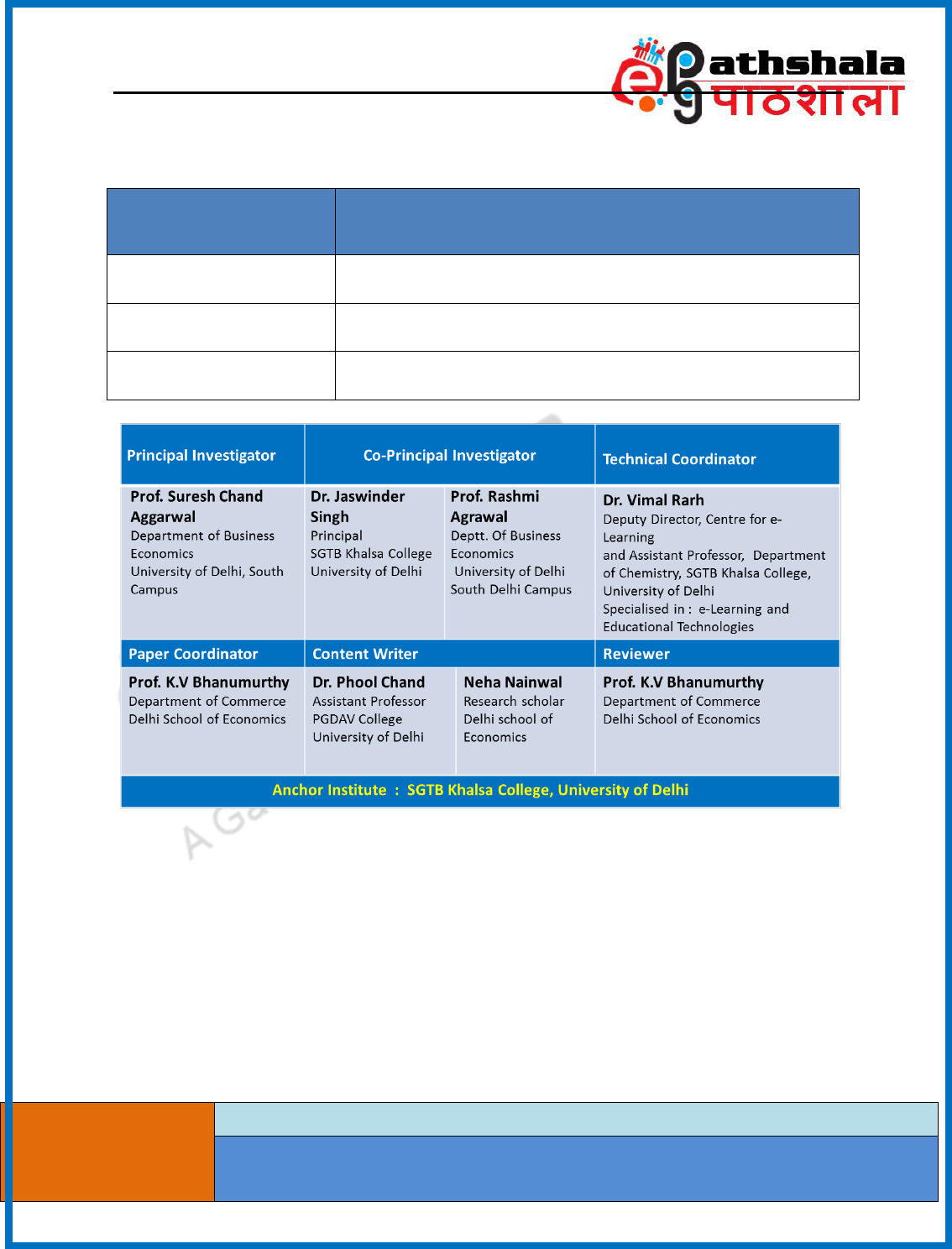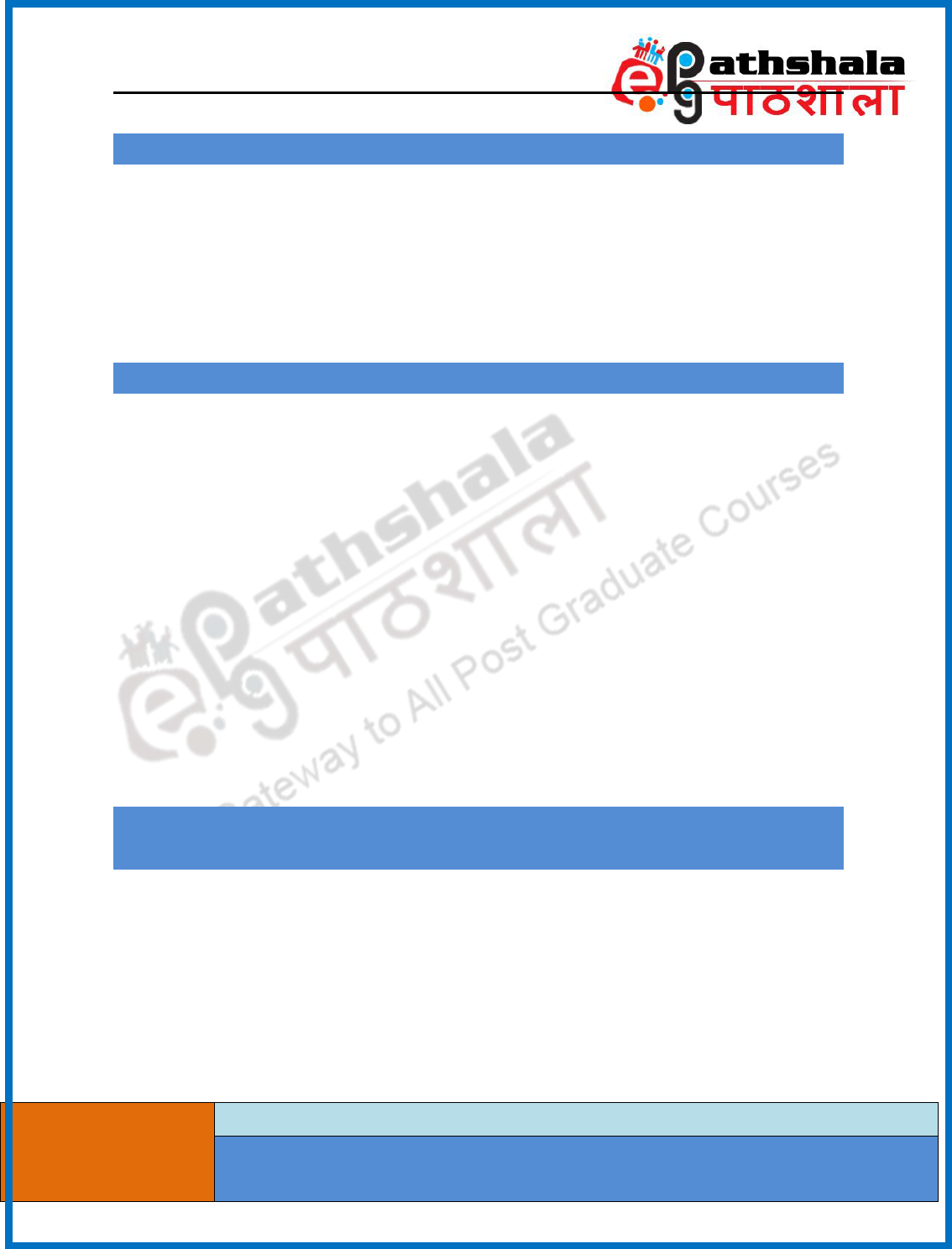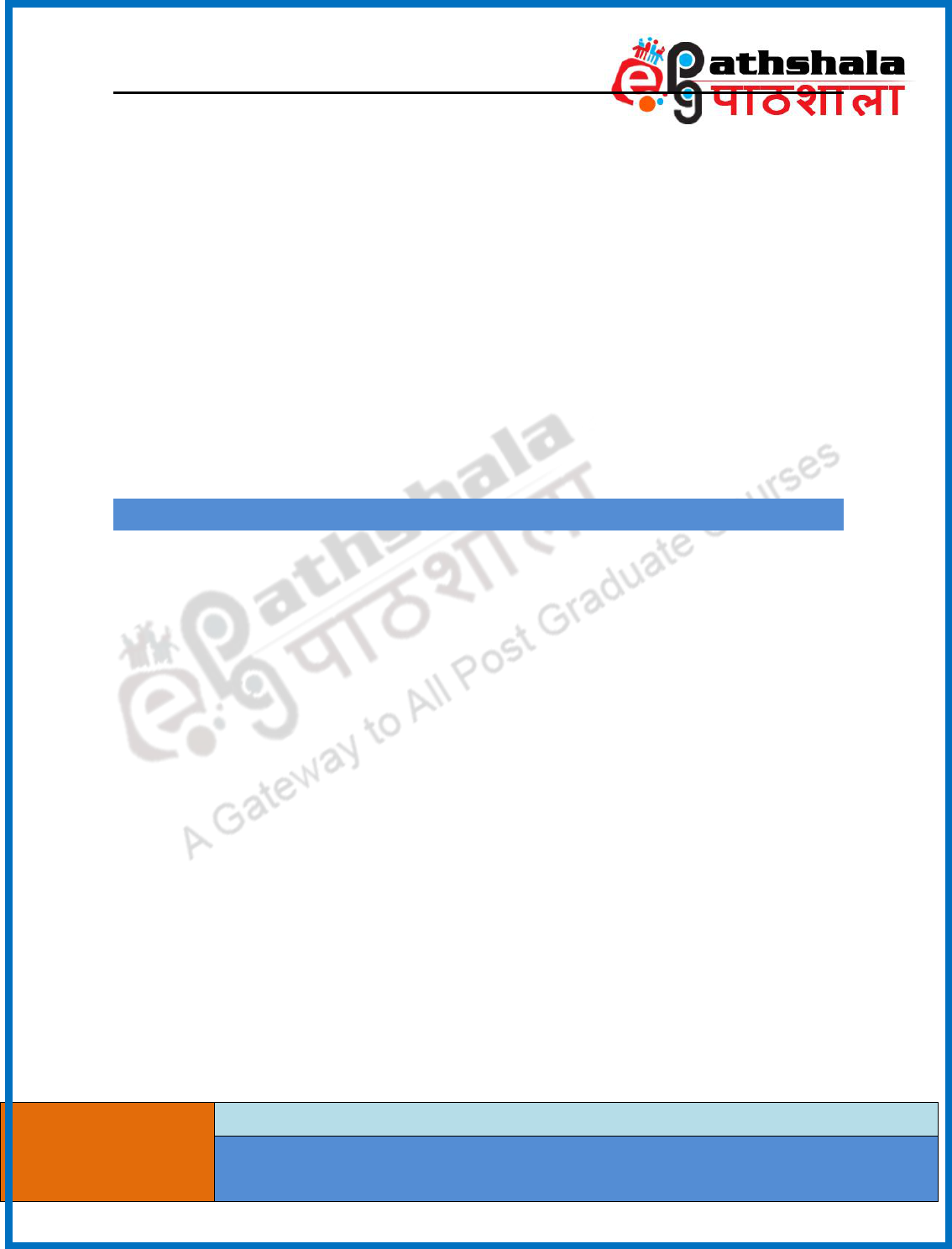
BUSINESS
ECONOMICS
PAPER No. 14: INTERNATIONAL FINANACIAL MANAGEMENT
MODULE No. 6: BID AND OFFER RATES
Subject
BUSINESS ECONOMICS
Paper No and Title
14: International Financial Management
Module No and Title
6: Bid and Offer Rates
Module Tag
BSE_P14_M6

BUSINESS
ECONOMICS
PAPER No. 14: INTERNATIONAL FINANACIAL MANAGEMENT
MODULE No. 6: BID AND OFFER RATES
TABLE OF CONTENTS
1. Learning Outcomes
2. Introduction
3. Concept of Quoting Bank, Calling Bank, Price Maker and Price Taker
3.1 Quoting Bank and Calling Bank
3.2 Price Maker and Price Taker
4. Bid and Offer (Ask) rates
5. Bid and Offer Rates in the Money Market
6. Bid and Offer Rates in the Foreign Exchange Market
7. Bid-Offer Spreads
7.1 Reference Rate
7.2 Relationship between Bid and Offer Prices of Currencies
7.3 Formation of Bid and Offer Rates
7.4 Spread or Cost of Transaction
7.5 Determinants of Spread
8. Summary

BUSINESS
ECONOMICS
PAPER No. 14: INTERNATIONAL FINANACIAL MANAGEMENT
MODULE No. 6: BID AND OFFER RATES
1. Learning Outcomes
After studying this module, you shall be able to
Understand the concept of quoting bank ,calling bank , price maker and price taker
Understand bid and offer rates in the money market
Understand bid and offer rates in the money market
Compute bid- offer spread and its determinants
2. Introduction
The spot quotation always gives one rate i.e., USD/INR 52.75. But in contrary to this, in any
market place, buyers and sellers give their own buying and selling rate. Hence at a given point of
time, there are two rates available. These two rates are known as “bid” and “ask” rates. Bid-ask
rates are given by forex dealers who are willing to buy and sell forex at these rates. It is to be
noted that in a traditional market, the buyers and sellers are normally separate entities. For
example, buyers and sellers of commodity would be different. A buyer is a user of the commodity
while seller is the producer of the commodity. However in a forex market buyers and sellers can
be individual entities (exporters or importers) as well as a single entity buying and selling a
currency simultaneously. The difference between these two rates is known as bid-ask spread.
Different aspect of bid and ask rates are discussed in the session i.e., what is quoting bank, calling
bank, price maker and price taker. The concept of bid-ask rates has been explained with suitable
example. This chapter makes familiar reader with the concept of bid-offer rates in money market
and foreign exchange market. This is being followed by the concept of reference rate and how
bid-offer rates are constructed. At the end, the chapter analyse the possible determinants of
spread.
3. Concept of Quoting Bank, Calling Bank, Price Maker and Price
Taker
3.1 Quoting Bank and Calling Bank
It is customary in inter-bank markets for banks to quote two-way prices. There are two parties to
the quotation: the quoting bank and the calling bank. The quoting bank is the bank that quotes the
price. The calling bank is the bank that calls to ask the quoting bank for a price. Having been
quoted the price, the calling bank accepts it, in which case a deal is done, or rejects it, in which
case no transaction occurs.

BUSINESS
ECONOMICS
PAPER No. 14: INTERNATIONAL FINANACIAL MANAGEMENT
MODULE No. 6: BID AND OFFER RATES
3.2 Price Maker and Price Taker
When banks quote interest rates and exchange rates to customers it is often obvious whether the
customer wants to borrow, lend, buy or sell. Consequently, it is sufficient for the bank to quote a
one-way price. However, on occasions customers require two-way prices. A more general
description is to refer to the quoting bank as the price maker and the other party as the price
taker. Whenever two-way prices are quoted, the first rate quoted is known as the bid rate and the
second rate quoted is known as the offer rate.
4. Bid-Offer (Ask) Rates
Suppose Central Bank of India (CBI), a dealer in forex, is quoting bid-ask EURO/INR of 77.6025
to 77.6048 for spot transaction at 11.15am on 29
th
August 20XX.
Spot Rate by SBI
Bid
Ask
Euro/INR
77.6025
77.6048
In this quotation, Euro is the base currency while INR is variable/term/quote currency. Bid-ask
price is always expressed in terms of base currency.
The bid rate indicates that, CBI is willing to buy 1 Euro from the counterparty and pay INR
77.6025. The ask rate indicates that CBI is willing to sell (or give) 1 Euro to counterparty and
accept (or receive) INR 77.6048. In other words, for every Euro CBI buys and sells, it makes a
profit of INR 0.0013. Ask/offer rate is always lesser than bid rate.
While buying a currency, the traders pay a higher amount compared to selling the same amount
of the currency. The bid-ask spread is what the bank/foreign exchange dealer profits.
Table 1: Interbank Foreign Exchange Quotations
Exchange Rates
Bid
Offer
GBP/USD
1.62536
1.62576
GBP/AUD
1.7703
1.7714
JPY/USD
0.01136
0.0114
NZD/USD
0.73665
0.73705
AUD/USD
0.9145
0.9150
Source: http://www.hifx.co.uk/marketwatch.aspx
The quotations are for spot rates. While publishing quotations in any screen or over phone banks
quote the base currency first. In “GBP/USD” the GBP is the base currency and USD is the
variable/quote/term currency. Similarly, in “GBP/AUD”, GBP is the base currency while AUD is
the variable/quote/term currency.

BUSINESS
ECONOMICS
PAPER No. 14: INTERNATIONAL FINANACIAL MANAGEMENT
MODULE No. 6: BID AND OFFER RATES
The bid and ask rates are from the bank’s perspective. In the first row given in Table 12.2, at a
bid price of “1.62536”, the bank would buy 1 unit of base currency and sell 1.62536 units of
variable/quote/term currency. In other words, the bank will buy 1 GBP and pays 1.62536 of USD.
At an “ask price” of 1.62576, the bank is willing sell/offer 1 GBP and receive 1.62576 of USD.
If a company wants to sell 1mn GBP (the bank should buy 1mn GBP) and receive USD, then the
company would pay 1mn GBP to bank and receive USD162536. If the company wants buy 1mn
GBP (the bank to sell GBP), the company would pay USD162576. Bid–Ask spread determines
the profit for the bank. It is very important to understand at this point is, bid price is always lesser
than ask price.
Now if a company wants to buy or sell USD (as base currency), then which rates it would be able
to do so. The bid-ask rate of 1.62536-162576 will not be directly applicable. The rate needs to be
converted so that USD becomes the base currency and GBP becomes the variable/quote/term
currency. If we merely reverse the rates i.e., (1/1.62536) and (1/1.62576), we get a bid-ask spread
of (0.61524 - 0.61509).
5. Bid and Offer Rates in the Money Market
In the money market the bid rate is the rate at which the quoting bank is willing to borrow. The
offer rate is the rate at which the quoting bank is willing to lend. A bank quotes three month
dollars at 4.00%/4.25% p.a. The bid rate is 4.00% p.a. and the offer rate 4.25% p.a. In full, the
quoting bank is saying that it is willing to borrow dollars for three months at a rate of 4.00% p.a.
and to lend dollars for three months at a rate of 4.25% p.a. The price taker performs the opposite
side of the transaction to the quoting bank. If the price maker borrows then the price taker lends
and if the price maker lends then the price taker borrows. If the price taker wishes to borrow
dollars from the quoting bank, it must borrow at the offer rate (i.e. lending rate) of 4.25% p.a. If
the price taker wishes to lend dollars to the quoting bank, it must lend them at the bid rate (i.e.
borrowing rate) of 4.00% p.a. An alternative definition of the bid rate would be the rate at which
the price taker can lend. Similarly, an alternative definition of the offer rate would be the rate at
which the price taker can borrow;
Example 1
Bid and offer rates in the money market: 3 month dollars
Bid Rate Offer Rate
Quote 4.00% p.a. 4.25% p.a
Price Maker Borrows Lends
Price Taker Lends Borrows

BUSINESS
ECONOMICS
PAPER No. 14: INTERNATIONAL FINANACIAL MANAGEMENT
MODULE No. 6: BID AND OFFER RATES
6. Bid and Offer Rates in the Foreign Exchange Market
In the foreign exchange market the bid rate is the rate at which the quoting bank is willing to buy
the commodity currency. The offer rate is the rate at which the quoting bank is willing to sell the
commodity currency. A bank quotes spot €1 = US$0.8410/0.8415. The bid rate is 0.8410 and the
offer rate is 0.8415. In full, the quoting bank is saying that it is willing to buy euros at a rate of €1
= US$0.8410 and to sell euros at a rate of €1 = US$0.8415. The price taker performs the opposite
side of the transaction to the quoting bank. If the price maker buys euros then the price taker sells
euros, and if the price maker sells euros then the price taker buys euros.
If the price taker wishes to buy euros from the quoting bank, it must buy them at the quoting
bank’s offer rate (i.e. selling rate) of 0.8415.
If the price taker wishes to sell euros to the price maker, it must sell them at the price maker’s bid
rate (i.e. buying rate) of 0.8410. An alternative definition of the bid rate would be the rate at
which the price taker could sell the commodity currency. Similarly, an alternative definition of
the offer rate would be the rate at which the price taker could buy the commodity currency.
Example 2
Bid and offer rates in the foreign exchange market:
Spot rate €/US$ (commodity currency)
Bid Rate Offer Rate
Quote €1 = US$ 0.8410 0.8415
Price Maker Buys Euro Sells Euros
Price Taker Sells Euros Buys Euro
In the quotation €1 = US$0.8410/0.8415, the euro is the commodity currency and the dollar is
the terms currency. When a bank buys the commodity currency it sells the terms currency, and
when it sells the commodity currency it buys the terms currency.
The bid rate could also be defined as the rate at which the price maker is willing to sell the terms
currency or the rate at which the price taker is able to buy the terms currency.
The offer rate could also be defined as the rate at which the price maker is willing to buy the
terms currency or the rate at which the price taker is able to sell the terms currency.
Example 3
(Terms Currency)
Bid and offer rates in the foreign exchange market:
Spot rate €/US$ (commodity currency)
Bid Rate Offer Rate
Quote €1 = US$ 0.8410 0.8415
Price Maker Sells dollars Buys dollar
Price Taker Buys dollar Sells dollar

BUSINESS
ECONOMICS
PAPER No. 14: INTERNATIONAL FINANACIAL MANAGEMENT
MODULE No. 6: BID AND OFFER RATES
7. Bid-Offer Spread and its Determinants
7.1 Reference Rate
Reference rate is the rate issued by the central banks of countries. In India, it is issued by the RBI.
Everyday Reserve bank of India publishes reference rate for spot USD/INR and spot EUR/INR.
RBI reference rate is an indicative rate – what is the average foreign exchange rate prevailing on
a given date. This rate is also used by companies to convert their foreign currency import
payment and export receipt to INR for financial reporting.
The reference rates are arrived at by averaging the mean of the bid / offer rates polled from a few
select banks around 12 noon every week day (excluding Saturdays).The contributing banks are
selected on the basis of their standing, market-share in the domestic foreign exchange market and
representative character. The Reserve Bank periodically reviews the procedure for selecting the
banks and the methodology of polling so as to ensure that the reference rate is a true reflection of
the market activity.
7.2 Relationship between Bid and Offer (Ask) Prices of Currencies
One thing which is important to note about the bid and offer rate is that when a particular bank
quotes for a currency, it simultaneously offers another currency in lieu. It means if it buys dollars
for pounds, it is simultaneously offering pounds for dollars. Hence, there are two sides of all
quotes. It simply means that there is an inverse relationship between bid and offer rates. If we
know the bid price, its inverse will give us the offer price. In other words, the inverse of ask rate
of pounds will be equal to the bid rate of dollar.
In general terms we can write
S (x/bid y) = 1/S(y/ ask x) and S (x/ ask y) = 1/ S (y/bid x)
Where x and y are currencies of two countries
It basically states that relationship between bid and offer exists in term of direct and indirect
quotes of a particular foreign exchange rate.
7.3 Formation of Bid and Offer Rates
For computing bid and offer rates we need to have the reference rate as the mid-rate which is
issued by the RBI in India.
Let C is an indicator of cost of transaction. R is the reference rate or mid-rate.
Bid and ask quotes are then given as:
S (Bid) = M × (1-C), and

BUSINESS
ECONOMICS
PAPER No. 14: INTERNATIONAL FINANACIAL MANAGEMENT
MODULE No. 6: BID AND OFFER RATES
S (Offer) = M × (1+C)
Hence, Spread = S (Offer) – S (Bid) = M (1+C) – M (1-C) = 2C
From the above equations, it is clear that the spread equals twice the one side average cost of
transaction or it may be termed that one side of cost of transaction equals half the spread.
Example 1
(Direct quotation)
Suppose RBI reference rate is S (INR/USD) = 54.75 and if one way exchange margin to be
charged by authorised dealer is 0.4%, the direct bid and offer rates would be :
Bid Rate = 54.75 – 0.4% of 54.75 = 54.53
Offer Rate = 54.75 +0.4% of 54.75 = 54.97
Spread = Offer – Bid = 54.97- 54.53 = 0.44
7.4 Spread or Cost of Transaction
After understanding the relationship between bid and offer prices of currencies and also, the
formation of these two rates, now there is need to know the concept of spread or cost of
transaction. Spread, as we have noticed, is the offer and bid differential. Spread is also known as
the income own to a dealing bank or cost that occurred by the customer while dealing with the
bank. The computation of spread is different in different quotations. In case of direct quotation,
spread is computed by a ratio of “offer-bid/offer”. In case of indirect quotation, spread is
computed by a ratio of “bid-offer/bid”.
For example, the bid price of dollar at spot market, USD/INR = 55.7621 and the offer price is,
USD/INR = 55.8024, the cost of transaction would be
(Offer-bid)/offer × 100 = (55.8024 – 55.7621)/ 55.8024 × 100 = 0.0722%.
If we consider the indirect quotation,
Offer price = 1/ offer price (direct quotation) = 1/55.8024 = 0.017920
Bid price = 1/bid (direct quotation) = 1/ 55.7621 = 0.017933.
Now, the cost of transaction = (bid – offer)/ bid ×100
(0.017933 - 0.017920) /0.017933 × 100 = 0.0725%
6.5 Determinants of Spread
The main determinants of spread are:
a) Bank versus Money Changer: - the cost of transaction of foreign exchange dealings
also depends on the nature of organisation making foreign exchange rate quotations. If a
bank is making quote, the spread will be smaller as compared to a money changer or a
finance company which has obtained license to deal in foreign exchange transactions.

BUSINESS
ECONOMICS
PAPER No. 14: INTERNATIONAL FINANACIAL MANAGEMENT
MODULE No. 6: BID AND OFFER RATES
The authorised dealer earns high amount of spread because he deals in very small volume
as compared to a bank having a bulk amount of foreign exchange dealings, therefore, the
cost of service per unit of currency traded is lower as compared to the authorised dealer.
b) Fairly versus Rarely Currency: - if the currency is fairly traded, the spread will be
smaller than the currency that is rarely traded. Dollar being a universally acceptable
currency will have a low amount of spread as compared to Danish Krone which is not
fairly traded.
c) Trading Volume of Currency: - if the volume of the currency traded is small, the
authorised dealer tends to quote higher spreads, this is because the cost of transaction
required per unit of the currency traded, tends to fall in the subsequent period.
d) Currency Rate Volatility: - irrespective of nature of organisation, a high volatile
currency will have a large amount of spread possibility to offset the unfavourable impact
of currency fluctuation.
e) Perception about Economic Conditions and Forex Market:- in the near future, if there
is possibility that economic conditions would be volatile and hence lead to high risk, the
dealer will increase the amount of spread on the foreign exchange dealing.
However, a stable economic condition would lead stability in the cost of service, i.e.,
spreads.
8. Summary
Quoting bank is the bank that quotes the price.
Calling bank is the bank that calls to ask the quoting bank for a price.
Quoting bank is also known as price maker, whereas, calling bank is termed as price
taker.
In the money market the bid rate is the rate at which the quoting bank is willing to
borrow. The offer rate is the rate at which the quoting bank is willing to lend.
In the foreign exchange market the bid rate is the rate at which the quoting bank is
willing to buy the commodity currency. The offer rate is the rate at which the quoting
bank is willing to sell the commodity currency.
Bid-offer price is always expressed in terms of base currency.
Bid-offer rates are from the bank’s perspective.
Bid-offer spread determines the profit for the bank.
In case of direct quotation, bid price is always lesser than the offer price.
In case of indirect quotation, offer price is always lesser than the bid price.
Reference rate is the rate issued by the central banks of countries. RBI reference rate is an
indicative rate – what is the average foreign exchange rate prevailing on a given date.

BUSINESS
ECONOMICS
PAPER No. 14: INTERNATIONAL FINANACIAL MANAGEMENT
MODULE No. 6: BID AND OFFER RATES
This rate is also used by companies to convert their foreign currency import payment and
export receipt to INR for financial reporting.
There is an inverse relationship between bid and offer rates.
Inverse relationship basically states that relationship between bid and offer exists in term
of direct and indirect quotes of a particular foreign exchange rate.
In case of direct quotation, spread is computed by a ratio of “offer-bid/offer”.
In case of indirect quotation, spread is computed by a ratio of “bid-offer/bid”.
In the case of direct quotes, the spread is in terms of domestic currency, whereas, it is in
terms of foreign currency when the quotes are indirect.
Volume of spreads are determined by the nature of organisation, trading volume of
currency, availability of currency, currency rate volatility and perception about the
economic conditions of a country.
